Tin-glazing is a popular pottery technique that is seen in many European ceramics such as Maiolica, Delftware and Faience. Introduced by the Moors as Hispano-Moresque ware, it was not until the 15th century that tin-glazed earthenware took hold as one of the leading forms of decorative art in the western world. It is this renaissance period that still attracts many collectors, historians and admirers.
 Above: a selection of tin-glazed pottery including charger plates, an apothecary pot, decorative tiles and two albarello jars
Above: a selection of tin-glazed pottery including charger plates, an apothecary pot, decorative tiles and two albarello jars
Our studio is home to an expert ceramic conservator who can sensitively revive and restore tin-glazed earthenware following accidental damage or age-related deterioration. This article will look into the history of famous pottery styles, as well as care tips on how to protect your treasured pieces and the restoration results that can be achieved.
 Above: a charger plate before and after restoration by our ceramics conservator
Above: a charger plate before and after restoration by our ceramics conservator
Maiolica
Maiolica is the term used to describe Italian tin-glazed earthenware, the most famous being produced during the renaissance in northern and central Italy. Cities famous for renaissance Maiolica include Urbino, Gubbio, Deruta, Castel Durante, Florence and Faenza.
 Above: examples of Maiolica earthenware including an albarello, an elaborate inkstand, plates with typical designs and a pharmacy jar
Above: examples of Maiolica earthenware including an albarello, an elaborate inkstand, plates with typical designs and a pharmacy jar
The word itself stems from the medieval name for Majorca, as this island was on the trade route that brought Hispano-Moresque wares to Italy. The word was originally used to describe all lustreware, whether it was made in Italy or Spain. You may also come across the term Majolica, but this is simply the anglicized version of Maiolica.
 Above: a detail from an istoriato scene showing the mythical story of Theseus and Achelous
Above: a detail from an istoriato scene showing the mythical story of Theseus and Achelous
Maiolica often features historic scenes and stories – known as istoriato ware – or decorative patterns and portraits. Traditional colours are copper green, cobalt blue, manganese purple, antimony yellow and iron-oxide orange. Reds and pinks from gold chloride were introduced in the 18th century as Maiolica ware had to compete with the bright glazes of newly developed porcelain.
 Above: a selection of maiolica plate designs featuring typical decoration and istoriato scenes
Above: a selection of maiolica plate designs featuring typical decoration and istoriato scenes
The Della Robbia family are the most famous artists to have used Maiolica throughout their work. Luca Della Robbia was known for his tin-glazed terracotta, a technique that he passed on to his nephews.
 Above: a selection of sculptural work by the Della Robbia family
Above: a selection of sculptural work by the Della Robbia family
During his lifetime, Luca Della Robbia was famous throughout Europe for his sculptural pieces and this helped to further elevate the art of tin-glazed pottery.
 Above: our ceramics conservator working on a copy of a Della Robbia artwork from a church local to our Belgravia studio
Above: our ceramics conservator working on a copy of a Della Robbia artwork from a church local to our Belgravia studio
The value of antique Maiolica can reach significantly high prices at auction, particularly good examples from the Italian renaissance such as istoriato charger plates. In 2012, Christie’s London sold a 16th century Maiolica charger plate for £457,250. Desirable Maiolica can surpass £50,000 to £100,000 at auction.
 Above: a selection of typical maiolica albarello jars used for storage and apothecary items
Above: a selection of typical maiolica albarello jars used for storage and apothecary items
Delftware
Inspired by the styles of Italian Maiolica, Dutch tin-glazed pottery spread from Antwerp to Haarlem, Middelburg and Amsterdam in the late 16th century. The finest examples of glazed pottery came from Delft, where potters began to put maker’s marks and monograms on their work. Delftware reached its height of popularity throughout Europe from 1640 to 1740.
 Above: examples of Dutch Delftware including two plates and a vase suitable for displaying tulips
Above: examples of Dutch Delftware including two plates and a vase suitable for displaying tulips
The traditional blue and white decoration – known as Delft blue – would have been inspired by Asian ceramics from the 14th century onwards. The blue used in Delftware is generally from cobalt oxide covered in a white tin glaze, this was later covered in another layer of clear glaze, allowing the pottery to mimic fine bone china.
 Above: detail of a Delft tile from the late 17th century
Above: detail of a Delft tile from the late 17th century
Like the invention of European porcelain (find out more about porcelain in our Meissen article here) Delftware positioned itself to take over from the imported Chinese ceramics that had previously dominated a market that was exclusive to aristocracy. Blue and white ceramic exports from China were known as Kraak ware, produced in the late Ming Dynasty as a foreign luxury for wealthy Europeans – you will often see Kraak ware featuring in Dutch Golden Age paintings as a sign of prosperity.
 Above: a selection of Delft plates that have patterns inspired by earlier work from Asia
Above: a selection of Delft plates that have patterns inspired by earlier work from Asia
Tin-glazed pottery from England is often called English Delftware. It was brought from the continent by two craftsmen from Antwerp in the mid 16th century and was originally called Galliware. English Delftware was popular with apothecaries due to the way in which it could keep wet and dry substances in their stock, popular English Delftware often comprises small ointment pots, large drug jars and pill slabs. Like the Dutch variety, English Delftware based most designs on traditional Chinese decorations.
 Above: a selection of English Delftware including a puzzle jug, a bust of Charles I, a plate featuring William and Mary, and two posset pots
Above: a selection of English Delftware including a puzzle jug, a bust of Charles I, a plate featuring William and Mary, and two posset pots
Just like Maiolica, Delftware can also fetch high sums at auction. In 2019, a pair of large Dutch Delft tulipieres sold for over 1 million euros at Sotheby’s. In 2015, a 17th century English Delftware wine bottle sold for £96,100, it was a unique piece that would have belonged to a royalist during the English civil war. Several London Delft charger plates have also sold at Christie’s London for over £100,000 each. Depending on desirability, Delftware typically sells anywhere between £1,500 to £5,000 at auction.
 Above: Delftware examples including plates, a tile, two ewers, a ceramic bell, a pot and vases
Above: Delftware examples including plates, a tile, two ewers, a ceramic bell, a pot and vases
Faience
Faïence earthenware was produced in Rouen from the 1530s as a French variety of tin-glazed pottery. Styles that stand out include Faïence Parlante, pottery with decorative writing, mottos and banners suitable for apothecaries and kitchens and Faïence Blanche, an undecorated ceramic with a simple white glaze. During the French revolution, Faïence Patriotique was a popular style that included political mottos and symbols. The fashion and popularity of Faience ware diminished by the end of the 18th century.
 Above: a selection of French tin-glazing examples including plates, vases and an ewer
Above: a selection of French tin-glazing examples including plates, vases and an ewer
In 2021, a pair of faience vases sold for $16,250 and in 2018, a faience bust of Louis XV sold for $18,750, both from Christie’s New York. Typical sale prices range from £1000 to £4000.
 Above: a detail from a faience plate featuring a transfer illustration from the satirical work of J.J. Grandville
Above: a detail from a faience plate featuring a transfer illustration from the satirical work of J.J. Grandville
Mexican talavera pottery
Mexican tin-glazed pottery is known as Talavera, taking its name from origins in Talavera de la Reina, Spain. Famous centres of production can be found in San Pablo del Monte in Tlaxcala and the state of Puebla. Pottery manufacturing became popular in Mexico due to the natural abundance of clay and the use of earthenware tiles in local architecture. The golden age of Talavera is similar to that of Delftware, from 1650 to 1750. Talavera has traditional techniques and colours including mauve, blue, orange, yellow, black, and green.
 Above: a selection of Talavera examples including plates and jugs with a variety of designs
Above: a selection of Talavera examples including plates and jugs with a variety of designs
Morris & Co. tiles
The arts and crafts movement revived tin-glazed earthenware in the 19th century, partly due to a pre-raphaelite focus on medievalism and historic techniques. William Morris’s close friend and colleague William De Morgan designed many tin-glazed tiles with intricate patterns. Influenced by early Hispano-Moresque design, De Morgan created a ‘Persian palette’ consisting of purple, green, blue, red, and yellow. In May 2022, a large vase by William De Morgan sold for £63,000. In 2021, two tile panels sold for £22,500, far surpassing their estimate of £1000.
 Above: our ceramics conservator applying small amounts of pigment during the restoration of a William De Morgan tile in our London studio
Above: our ceramics conservator applying small amounts of pigment during the restoration of a William De Morgan tile in our London studio
Caring for antique earthenware
Our experts recommend that ceramics are kept at a steady 20 degrees celsius and around 45% humidity. High-value or personally important ceramics should be kept behind glass for ongoing preservation as the natural cracking of a glazed surface is the perfect location for dust and other airborne contamination to gather. Areas that have no glazing, such as the underside of a plate, may also be at a heightened risk due to a lack of protection upon the porous clay.
If you have an antique vase that you would like to display flowers in, consider placing a productive container inside so that the water is not in direct contact with the ceramic.
 Above: a maiolica strawberry basket before and after restoration by our ceramics conservator
Above: a maiolica strawberry basket before and after restoration by our ceramics conservator
When it comes to cleaning your earthenware, it is recommended that no more than a light dusting with a clean and soft brush is used with no water or cleaning products. Hold the piece steadily as it is cleaned to avoid knocks and falls. Any intense cleaning or removal of dirt and contaminants should be performed by a professional conservator with tailored solutions, as amateur cleaning of embedded dirt and staining may lead to accidental damage.
If a ceramic object becomes damaged, always collect the pieces – no matter how small – so that our conservator can use as much of the original material as possible.
 Above: a ceramic figurine being sensitively cleaned in our studio before restoration of a failing historic repair on the arm
Above: a ceramic figurine being sensitively cleaned in our studio before restoration of a failing historic repair on the arm
Humidity and temperature with very little fluctuation will provide a consistent atmosphere and reduce any stress on the material, as deterioration may occur when a room shifts from cold to hot very rapidly. Consider placing the piece away from doors, open windows or radiators and fireplaces to avoid this fluctuation. Keeping your pottery away from an open fireplace, indoor smoking, or dusty areas will help to reduce any contamination buildup.
Professional pottery restoration
Our ceramics conservator uses museum-level expertise to sensitively restore tin-glazed earthenware. All restoration is carried out with as little impact on the historic and artistic integrity of the piece as possible, allowing it to retain value as an antique object. This means that damaged areas are repaired with as invisible a finish as possible and any new parts or retouching is completed sympathetically.
 Above: a maiolica vase before and after restoration by our ceramics conservator
Above: a maiolica vase before and after restoration by our ceramics conservator
Pottery restoration can consist of anything from the removal of stains to the repair and restoration of broken or missing pieces. The results in our studio have been remarkable, including recent work on a Delftware charger plate and a Maiolica vase, both of which had been shattered due to accidental falls before our conservator professionally restored them with expert precision.
 Above: a Delft blue charger plate before and after restoration by our ceramics conservator
Above: a Delft blue charger plate before and after restoration by our ceramics conservator
Unlike common household adhesives, our studio uses conservation-approved solutions to re-adhere pieces. This will ensure that no yellowing or acidic deterioration occurs. Plates, vases or other ceramic items that have been previously fixed at home with less than ideal superglues and tape can have this contamination removed and replaced with preservation-friendly techniques.
How can we help?
If you have antique or modern glazed pottery such as maiolica, delftware or faience in need of care or restoration, please speak to our helpful team. Email us via [email protected] or call 0207 112 7576

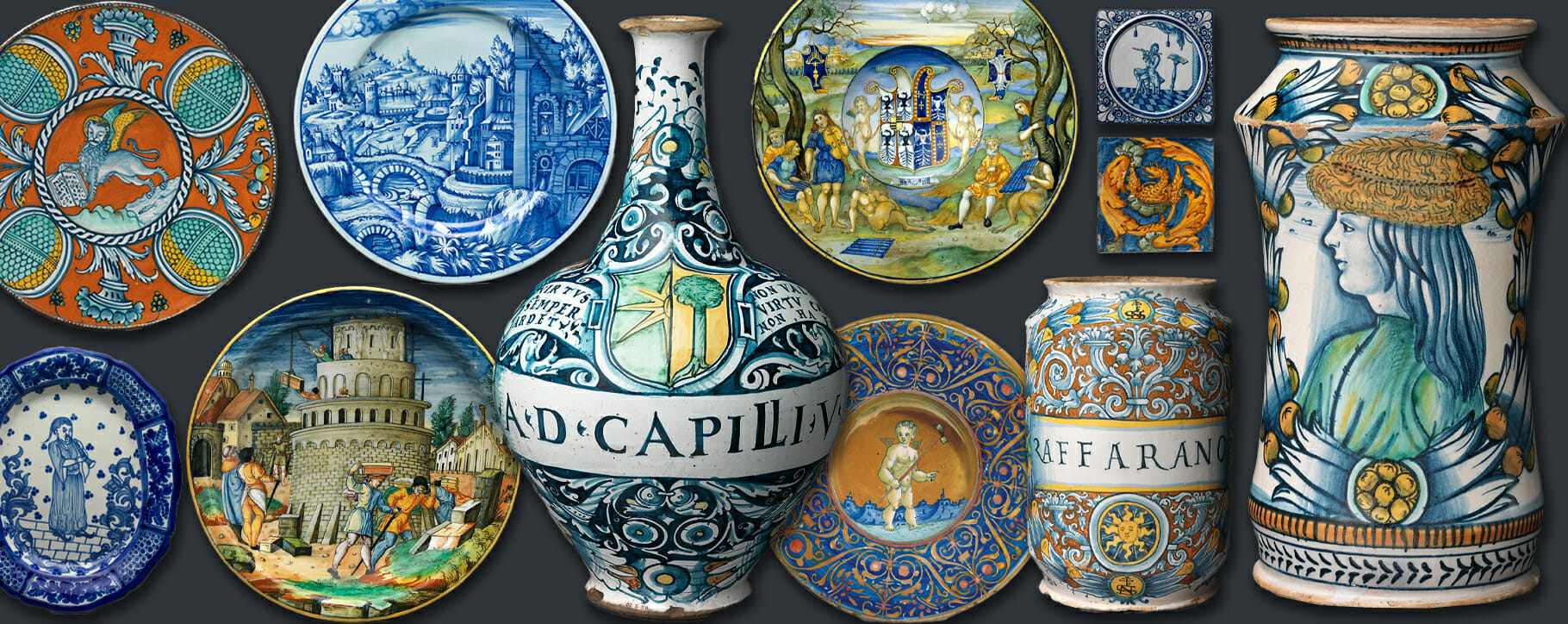 Above: a selection of tin-glazed pottery including charger plates, an apothecary pot, decorative tiles and two albarello jars
Above: a selection of tin-glazed pottery including charger plates, an apothecary pot, decorative tiles and two albarello jars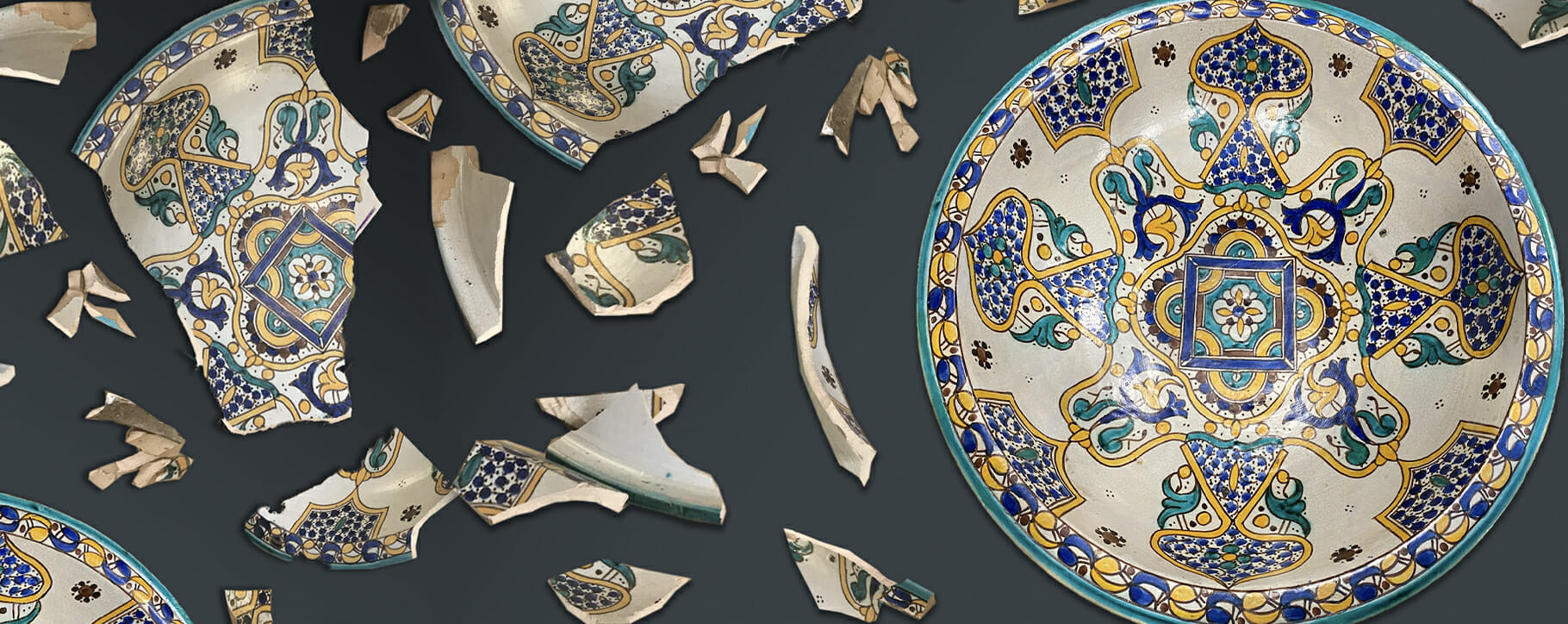 Above: a charger plate before and after restoration by our ceramics conservator
Above: a charger plate before and after restoration by our ceramics conservator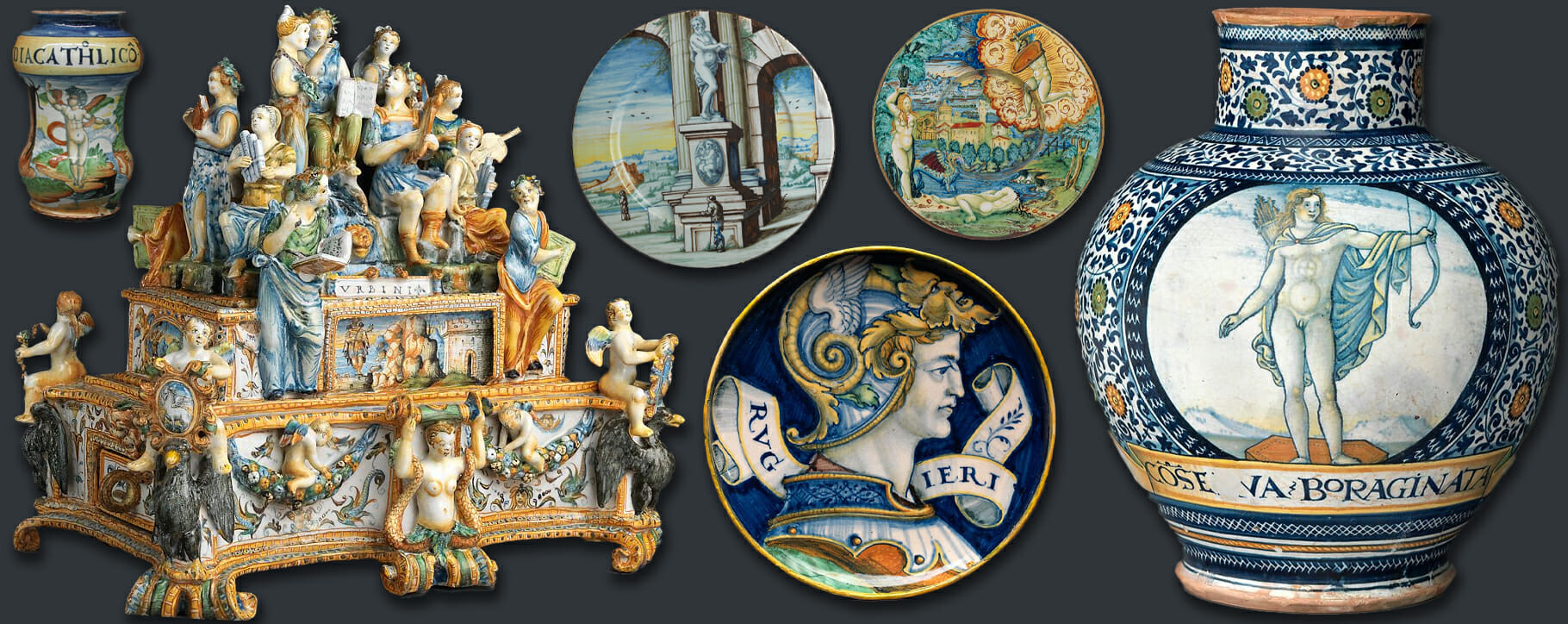 Above: examples of Maiolica earthenware including an albarello, an elaborate inkstand, plates with typical designs and a pharmacy jar
Above: examples of Maiolica earthenware including an albarello, an elaborate inkstand, plates with typical designs and a pharmacy jar 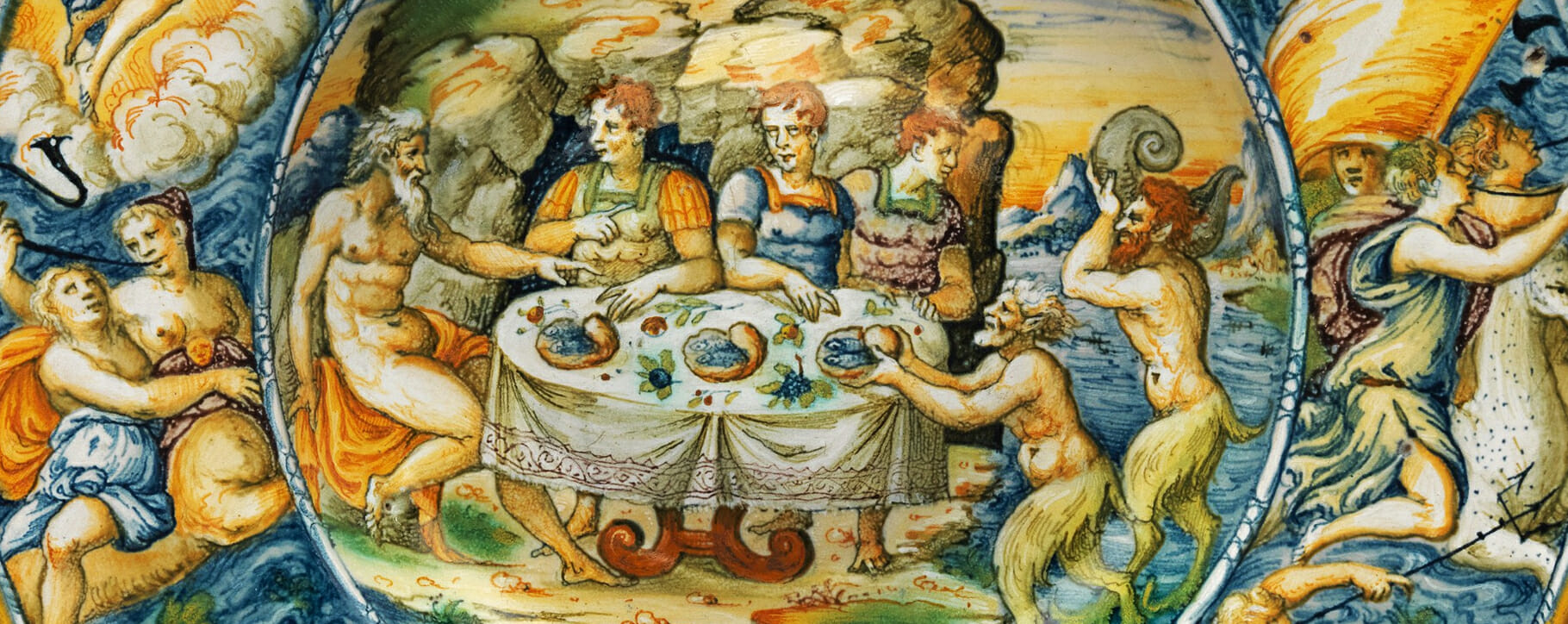 Above: a detail from an istoriato scene showing the mythical story of Theseus and Achelous
Above: a detail from an istoriato scene showing the mythical story of Theseus and Achelous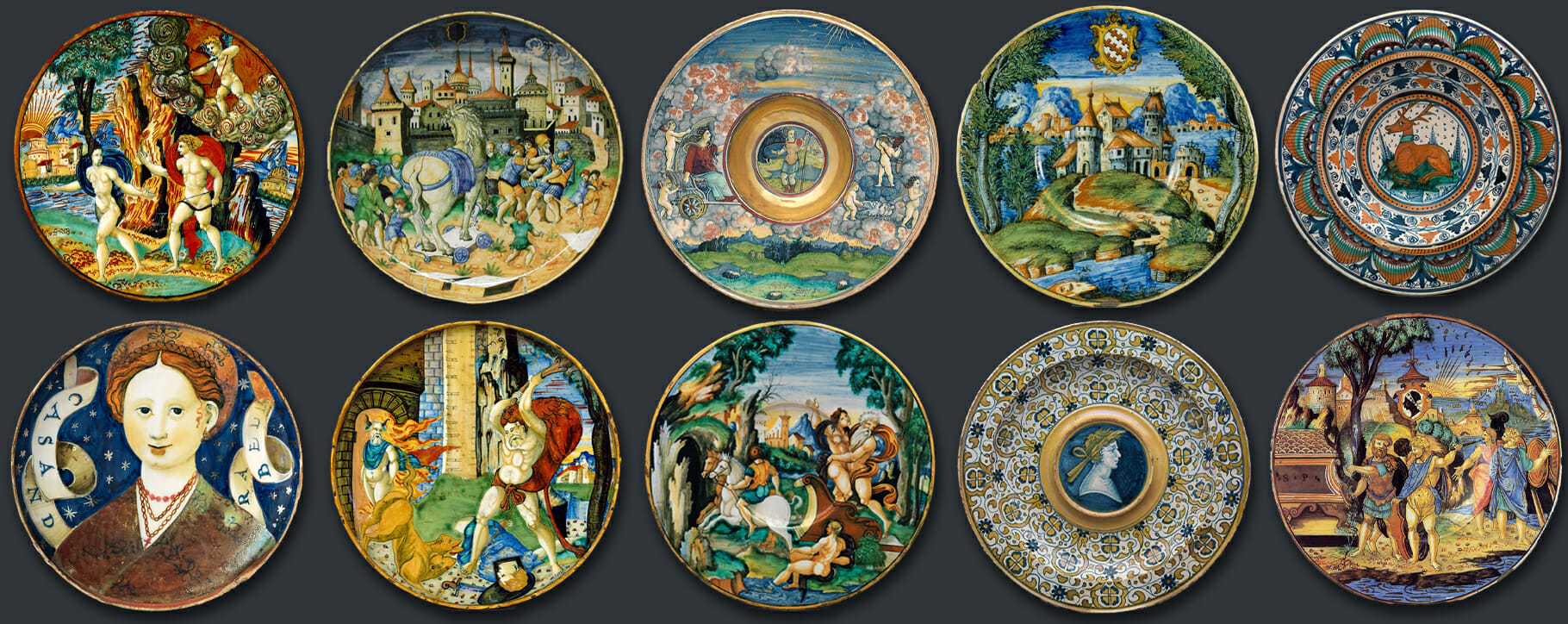 Above: a selection of maiolica plate designs featuring typical decoration and istoriato scenes
Above: a selection of maiolica plate designs featuring typical decoration and istoriato scenes Above: a selection of sculptural work by the Della Robbia family
Above: a selection of sculptural work by the Della Robbia family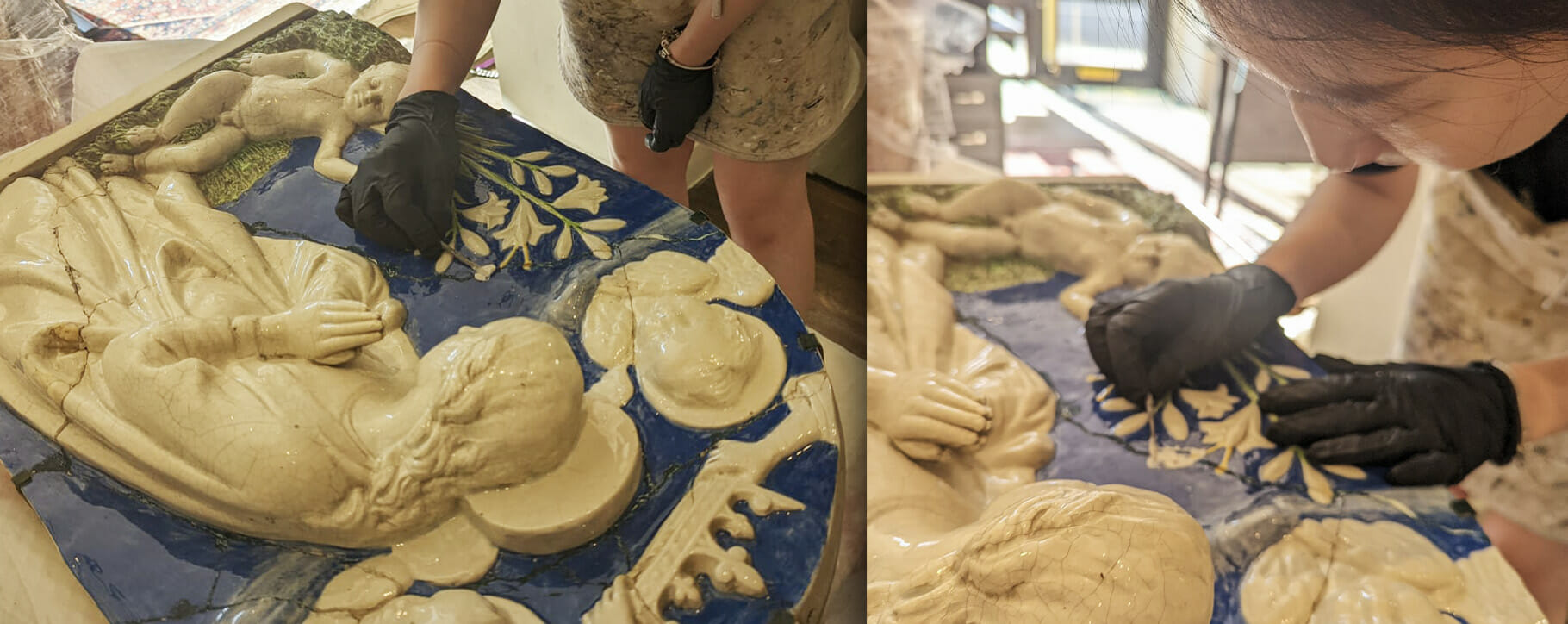 Above: our ceramics conservator working on a copy of a Della Robbia artwork from a church local to our Belgravia studio
Above: our ceramics conservator working on a copy of a Della Robbia artwork from a church local to our Belgravia studio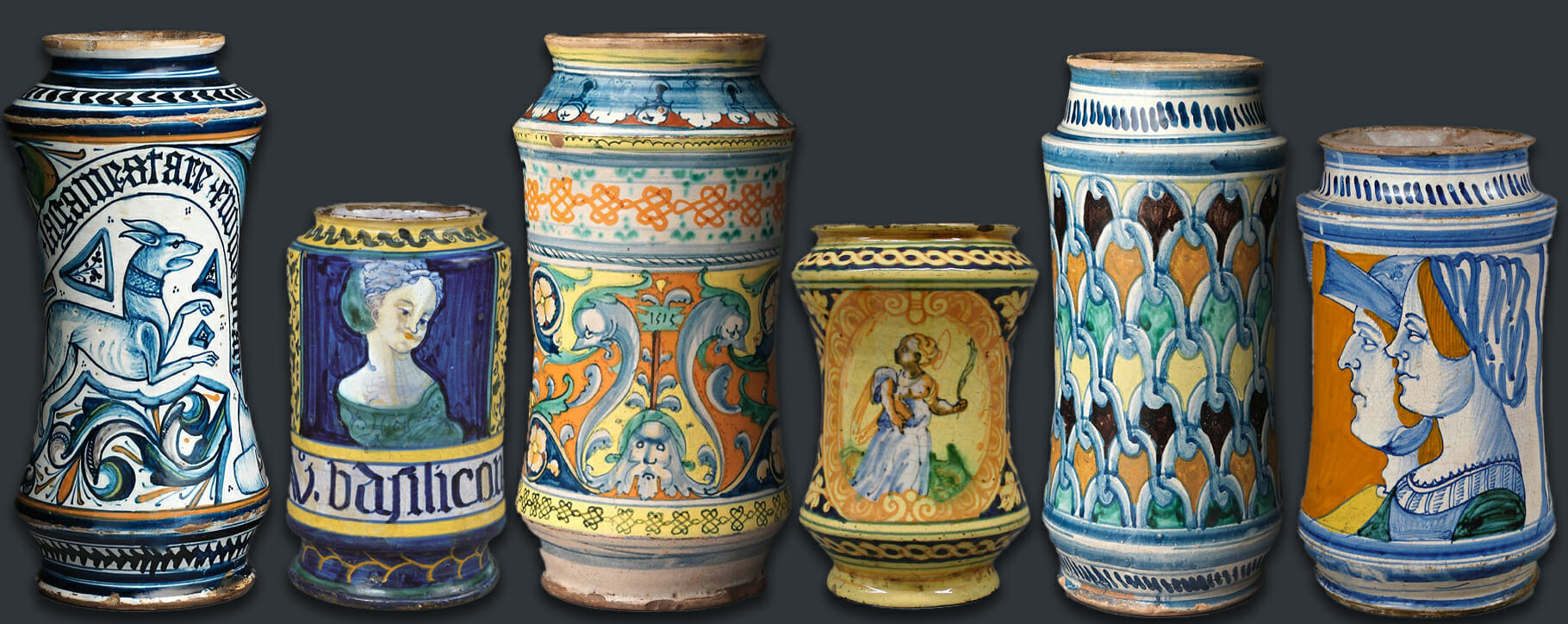 Above: a selection of typical maiolica albarello jars used for storage and apothecary items
Above: a selection of typical maiolica albarello jars used for storage and apothecary items Above: examples of Dutch Delftware including two plates and a vase suitable for displaying tulips
Above: examples of Dutch Delftware including two plates and a vase suitable for displaying tulips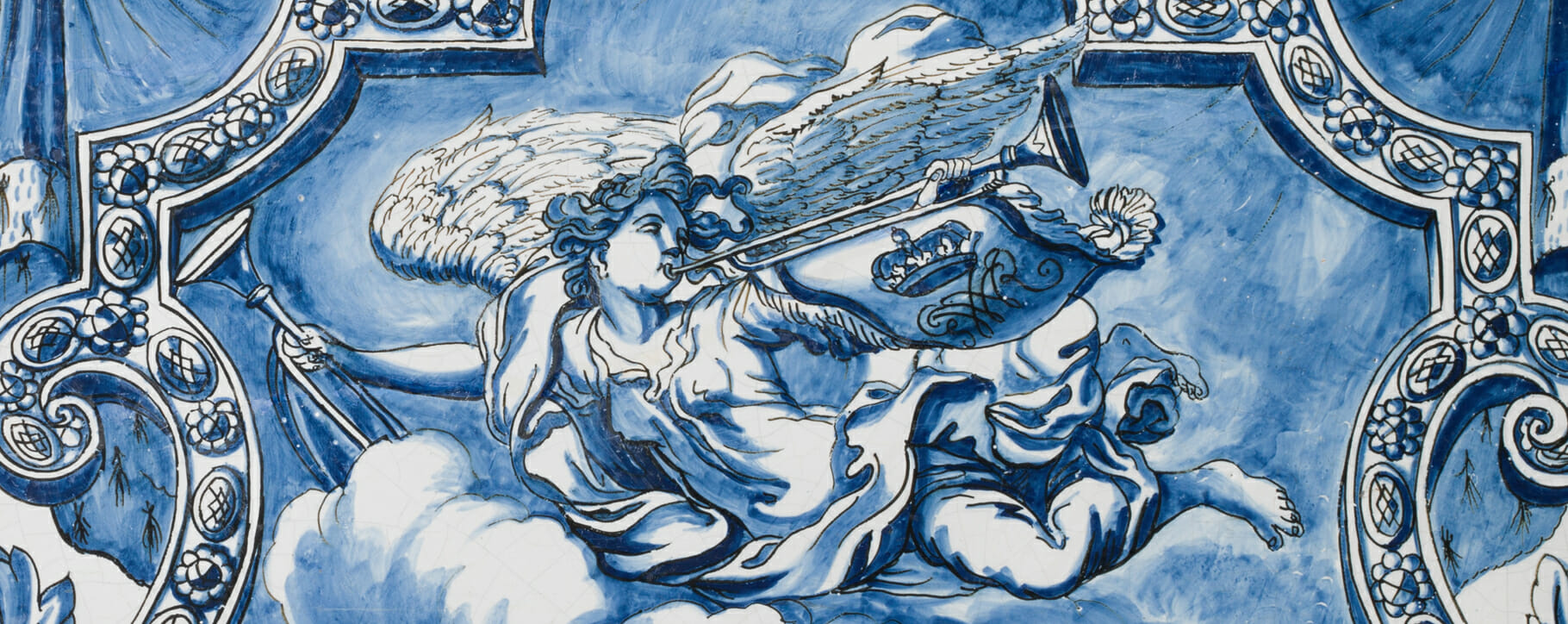 Above: detail of a Delft tile from the late 17th century
Above: detail of a Delft tile from the late 17th century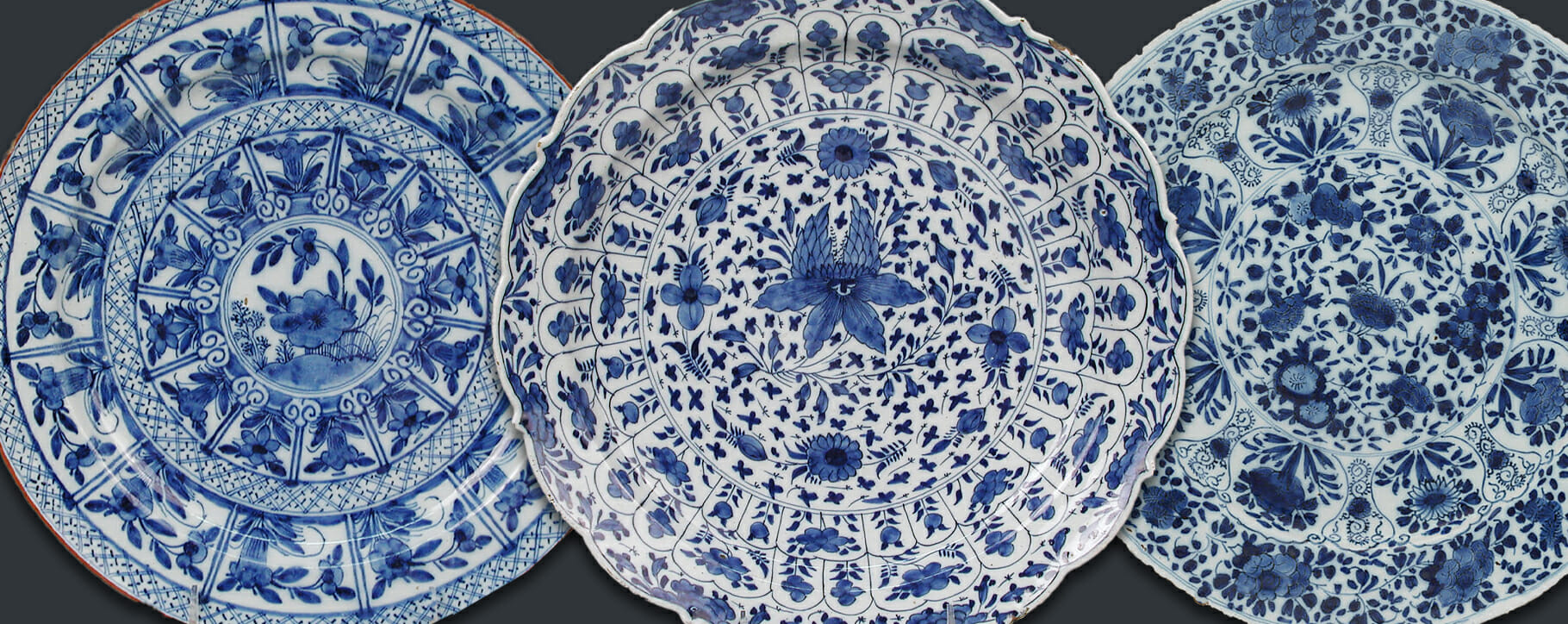 Above: a selection of Delft plates that have patterns inspired by earlier work from Asia
Above: a selection of Delft plates that have patterns inspired by earlier work from Asia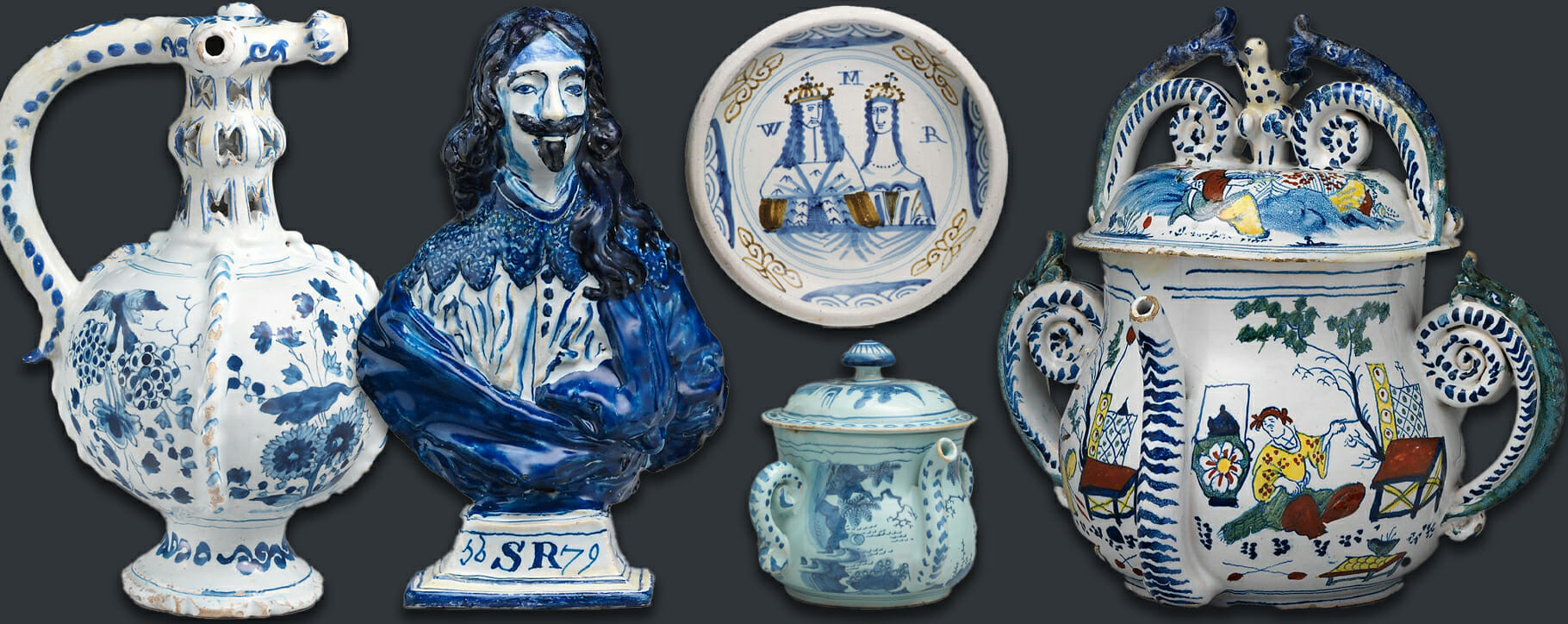 Above: a selection of English Delftware including a puzzle jug, a bust of Charles I, a plate featuring William and Mary, and two posset pots
Above: a selection of English Delftware including a puzzle jug, a bust of Charles I, a plate featuring William and Mary, and two posset pots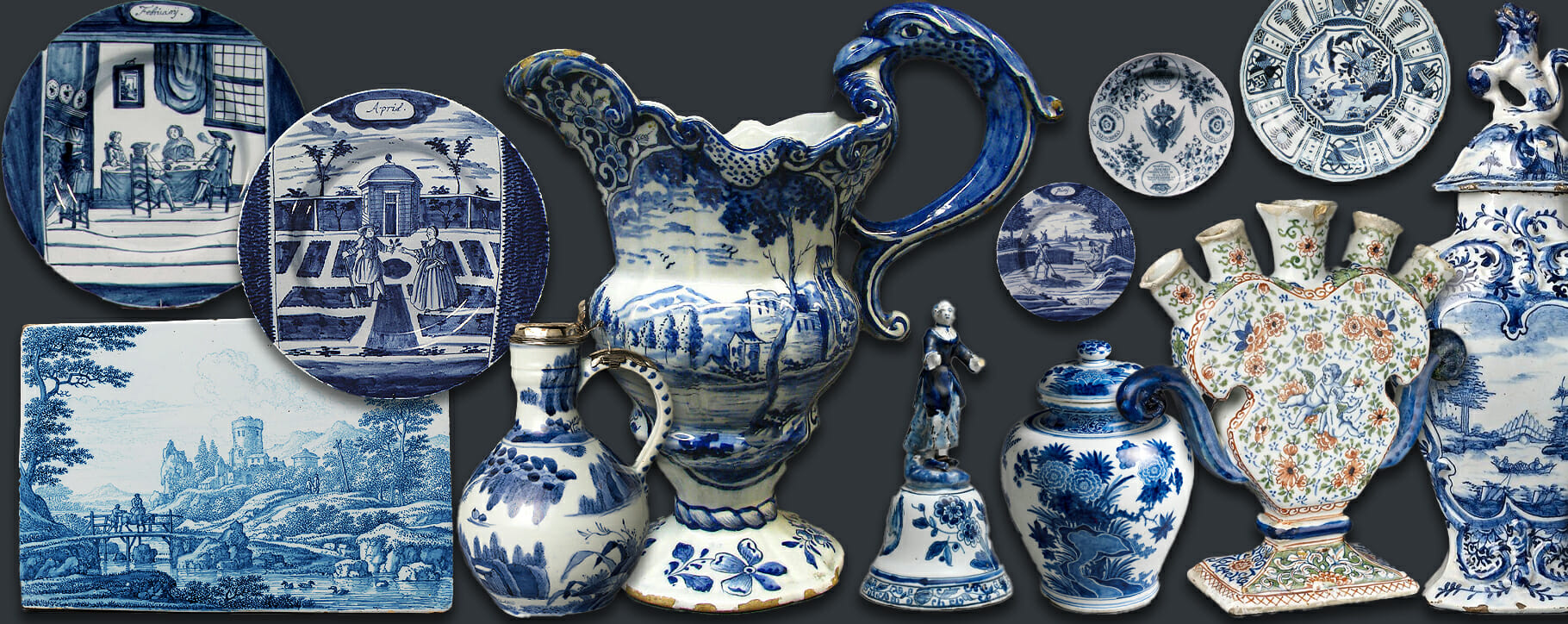 Above: Delftware examples including plates, a tile, two ewers, a ceramic bell, a pot and vases
Above: Delftware examples including plates, a tile, two ewers, a ceramic bell, a pot and vases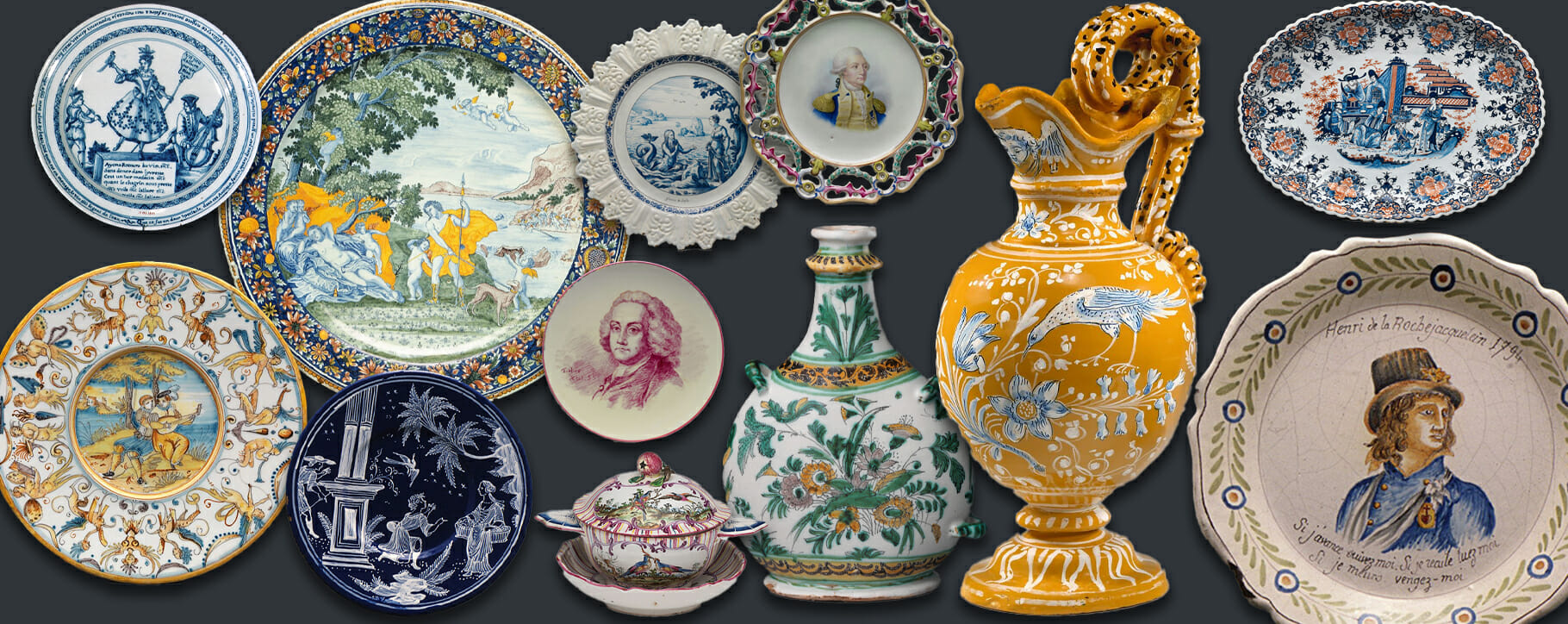 Above: a selection of French tin-glazing examples including plates, vases and an ewer
Above: a selection of French tin-glazing examples including plates, vases and an ewer Above: a detail from a faience plate featuring a transfer illustration from the satirical work of J.J. Grandville
Above: a detail from a faience plate featuring a transfer illustration from the satirical work of J.J. Grandville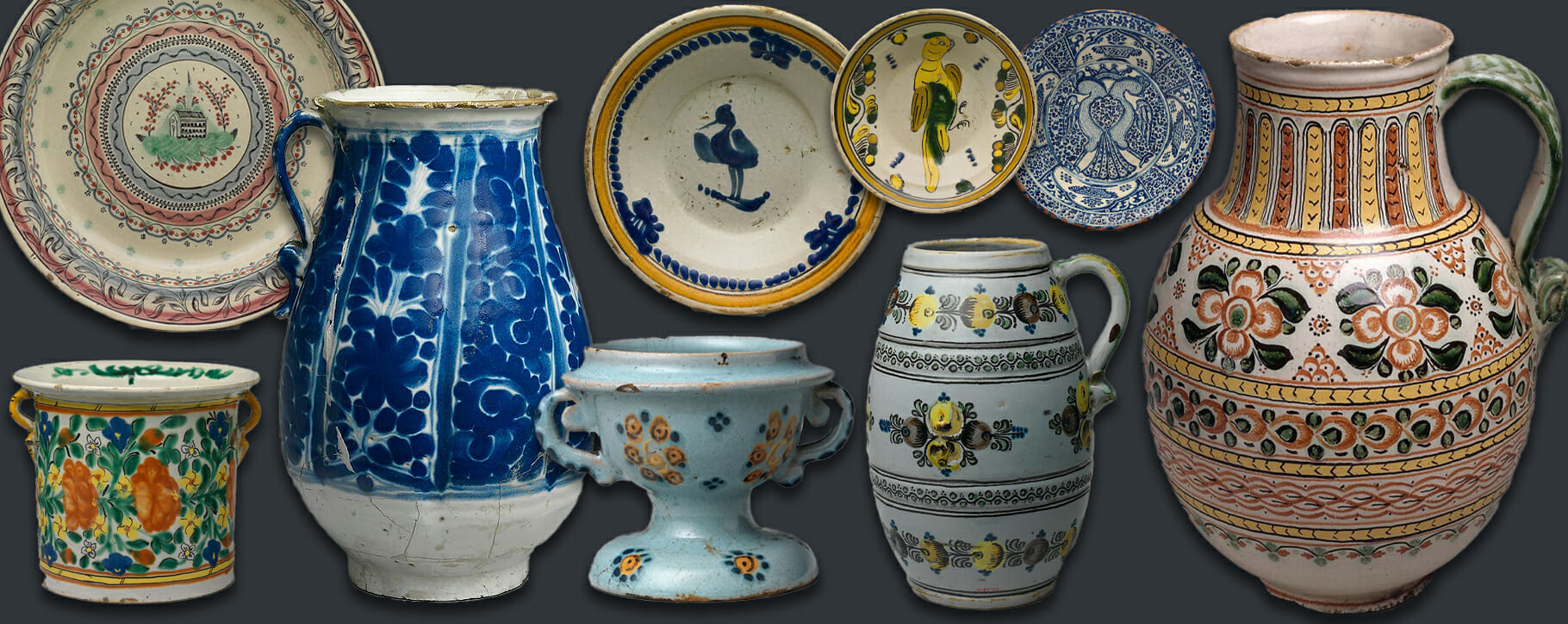 Above: a selection of Talavera examples including plates and jugs with a variety of designs
Above: a selection of Talavera examples including plates and jugs with a variety of designs Above: our ceramics conservator applying small amounts of pigment during the restoration of a William De Morgan tile in our London studio
Above: our ceramics conservator applying small amounts of pigment during the restoration of a William De Morgan tile in our London studio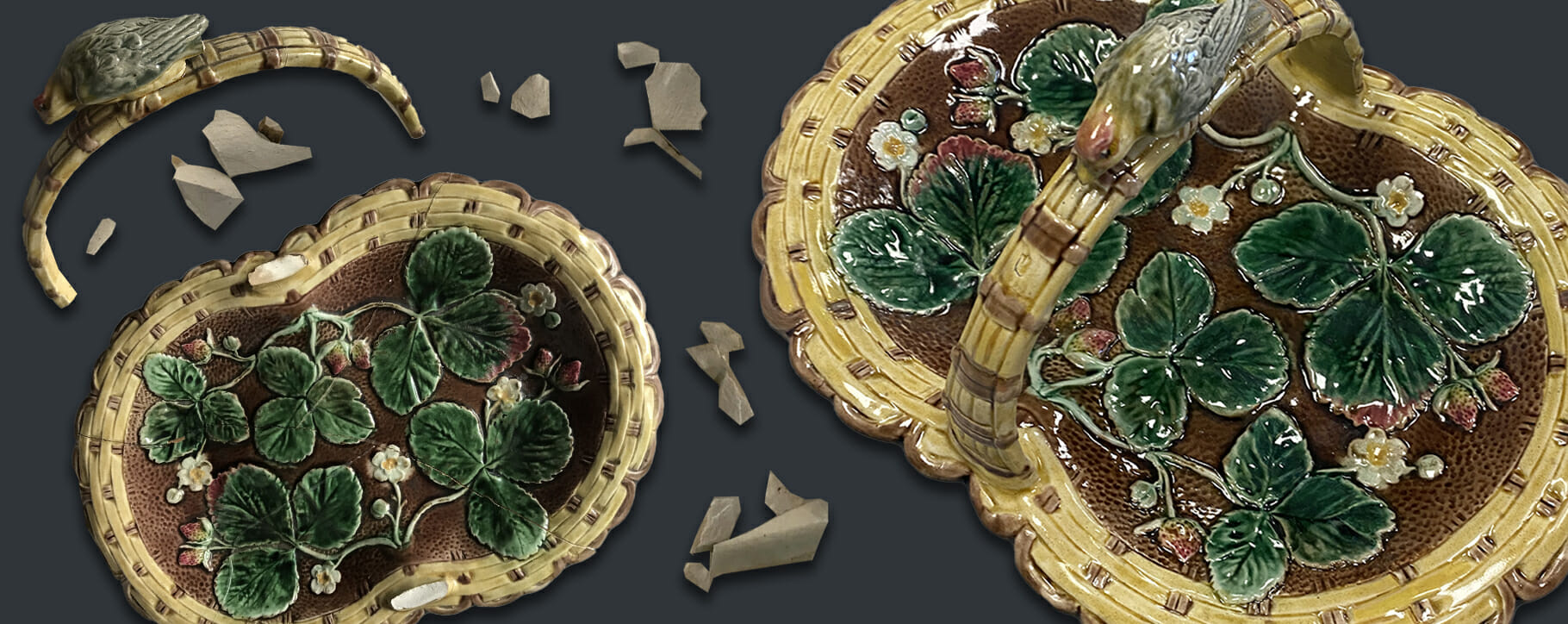 Above: a maiolica strawberry basket before and after restoration by our ceramics conservator
Above: a maiolica strawberry basket before and after restoration by our ceramics conservator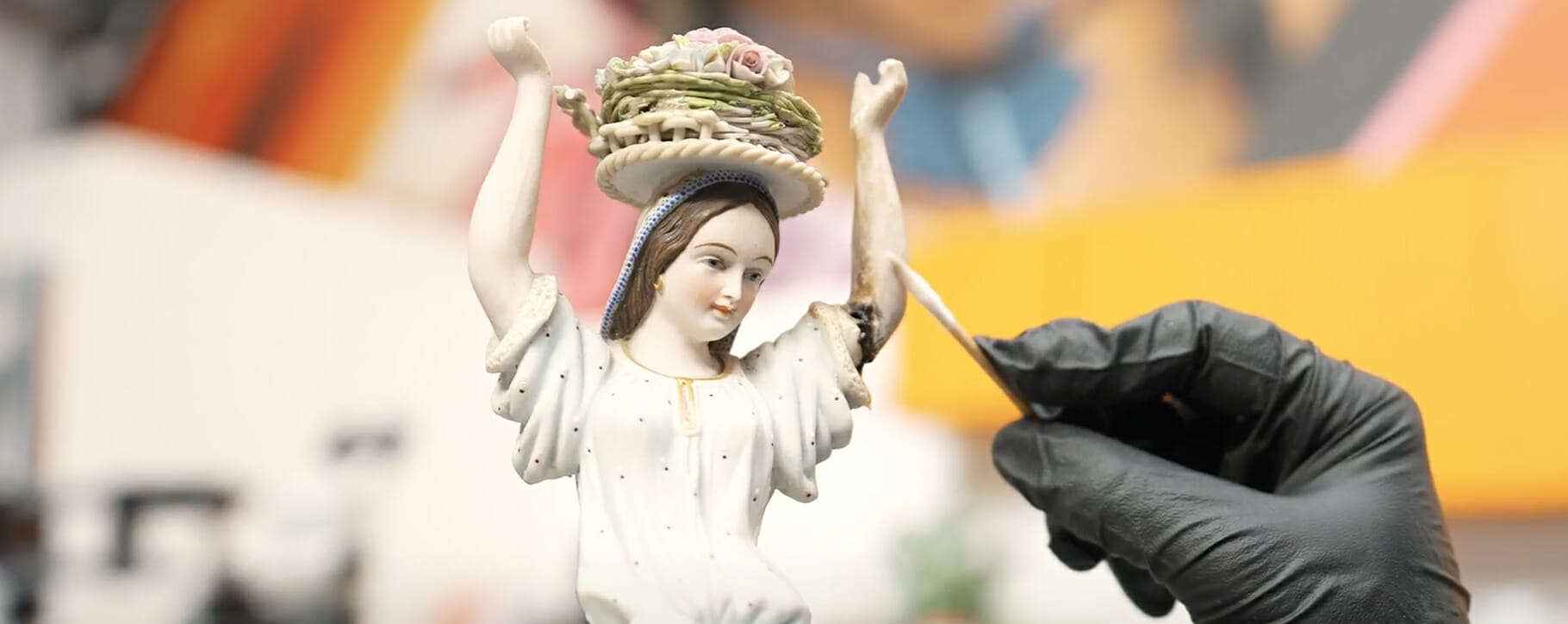 Above: a ceramic figurine being sensitively cleaned in our studio before restoration of a failing historic repair on the arm
Above: a ceramic figurine being sensitively cleaned in our studio before restoration of a failing historic repair on the arm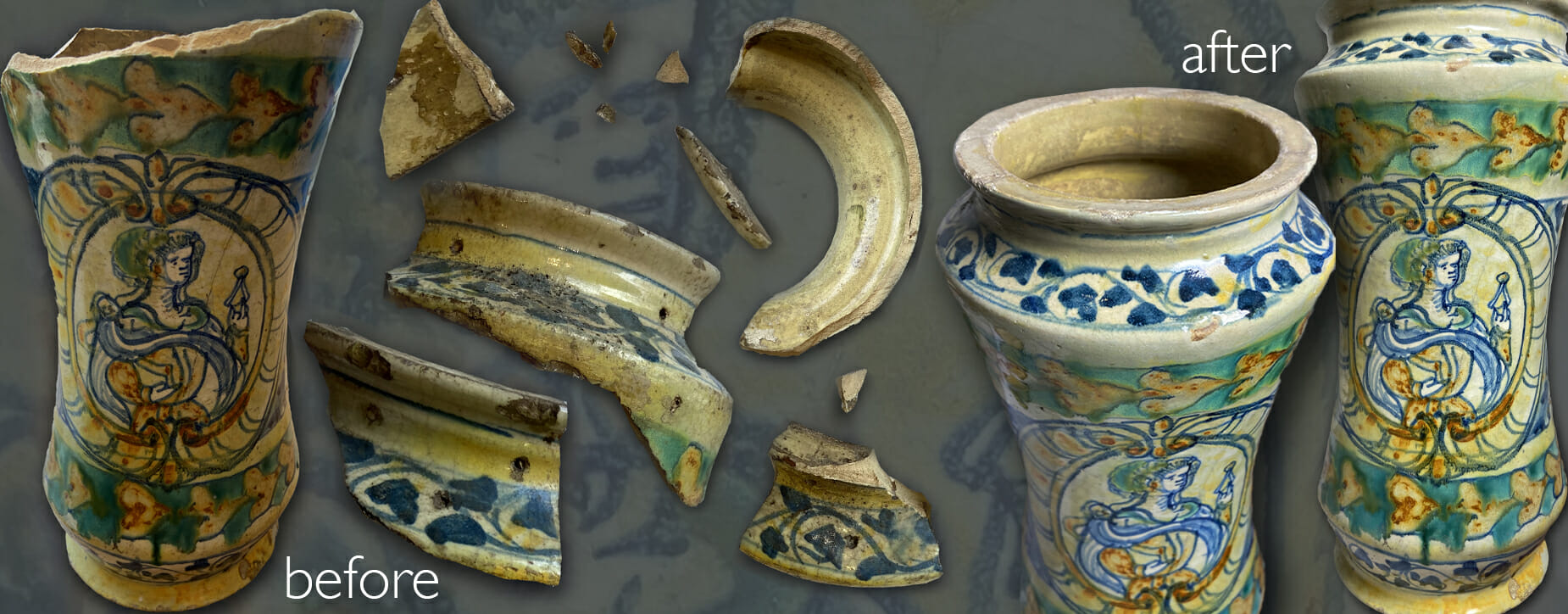 Above: a maiolica vase before and after restoration by our ceramics conservator
Above: a maiolica vase before and after restoration by our ceramics conservator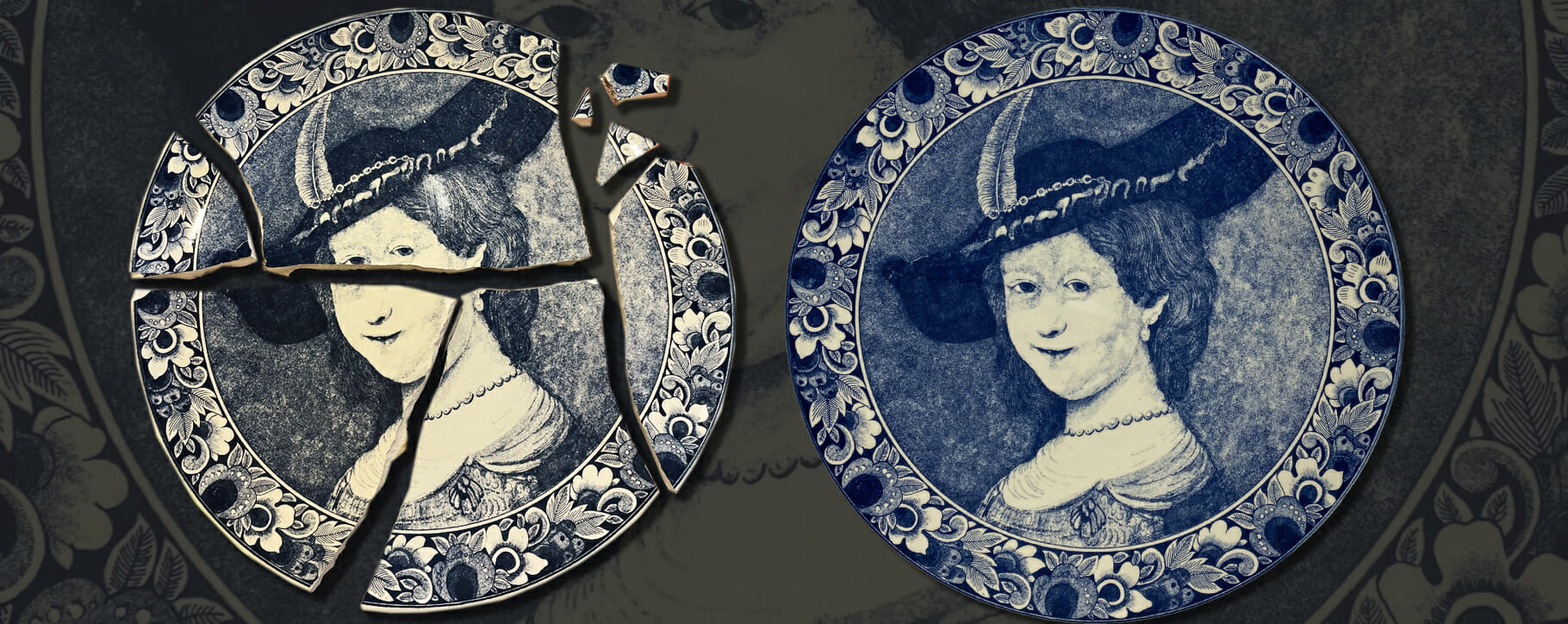 Above: a Delft blue charger plate before and after restoration by our ceramics conservator
Above: a Delft blue charger plate before and after restoration by our ceramics conservator




